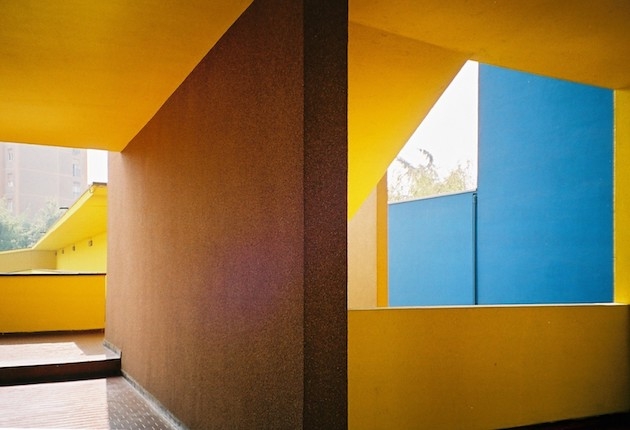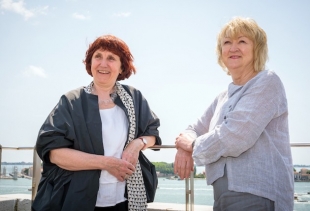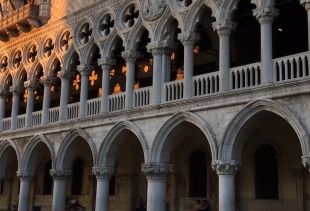» archive blog
-
Carnal, issue 0 of Parterre de Rois
A new magazine in Milandate: 18-07-2013
-
Interview with Nicola Toffolini
A worlds inventordate: 24-04-2011
-
Donne senza uomini.
Installazione multimediale di Shirin Neshatdate: 01-03-2011
Planet Earth as a client at Freespace
71 architects plus 29 in two special sections, 65 national participation and much more
‘The planet Earth as client’ - this is maybe the most touching statement of Freespace the manifesto founding the idea of curating an exhibition of architecture (and the next Architecture Biennale in Venice) according to Yvonne Farrell and Shelley McNamara, who are addressing this question to architects, so to have this crucial client served n tactical and strategic ways.
We discovered from their own words that the idea sparkled in a very unforeseen way during one of their journeys in Venice soon after they were appointed to curate the show. It arose with the observation of the Doge Palace wrapped in the typical Venetian fog. The Irish architects curating the 16th Mostra di Architettura di Venezia are the founders and principals of Grafton Architects (Ireland), a celebrated practice that in Italy has signed the new University Bocconi in Milan. The practice is very devoted to learning either by building campuses and by having intensive teaching programs.
The Biennale opens on May 26 and close on November 25th, 2018 after a couple of days of meetings with International architects (on Nov. 24 there will be exactly the one telling why Earth is the ultimate ‘client’).
After the booming figures recorded (also thanks to non-architect visitors) in the last Architecture Biennale curated by the Chilean Alejandro Aravena, the Italian cultural institution insists with the formula to consider architecture the most political form of art where citizens are called to an outstanding role, according to what declared today by the Biennale Chairman Paolo Baratta: to ask the most important questions, and the right ones whereas the institutions are not able to or are not sufficient for the task.
Architecture, therefore, is the antidote to dependance and to conformism. If we look carefully again to the renewed architecture show format - which has been designed by Koolhaas who rebranded it exactly in the edition occurring during the Milan World Expo bringing the festival to the challenging duration of six months - it embodies also the minor sisters (the Dance, Theatre and Music Biennales) and the worldly famous Movie festival. There is a roster of freshly designed formulas to visit all the festivals at once with flexible ticket entrances (and the Biennale Education sessions have been confirmed also this year and allow universities from everywhere in the world to visit the festival with dedicated programs).
Farrell and McNamara announced that the invited architects are 71, further those grouped in two special sections they invented: Close Encounters, meeting with remarkable projects with other 16 architects, The Practice of Teaching with other 13. They’d moved on the idea to do not show any project prior to the opening of the gate on May 26, because they want to ‘gift the immense surprise to come in Venice and see the outputs’.
With regards to the National participations, we will find them almost all gathered in Giardini and Arsenale this time (65 already present nations and 7 new ones: Antigua&Barbuda, Saudi Arabia, Guatemala, Lebanon, Mongolia, Pakistan, Holy Seed which will be not in Arsenale but in San Giorgio Maggiore, the Cini’s family island in front of San Marco Square).
At the time we write, the collateral events have been not yet communicated.
Among the invited architects, many are the returning firms: the previous curators like Elemental Studio by Aravena and SANAA by Sejima and Nishizawa, the artists-activists Assemble we’d already reviewed and also invited by Aravena on the last edition, then Siza, the Catalan practice EMBT, the Crimson, Chipperfield studio (working on the enlargement of the Venice Cemetery), BIG, Diller Scofidio+Renfro, Odile Decq and a few others.
There is the curious return of small Italian studio (like the Sicilian Grasso Cannizzo) or the presence of far away realities like Room 11 (Tasmania, Australia) and the Vietnamese VTN Architects.
If to hide the projects is fundamental for the surprise, the two curators were very generous in telling with care and with many details all the buildings or designs which touched them and inspired all along the preparation of the manifesto and then of the exhibition where they’re just sad to have been not able to invite more colleagues.
Their idea of architecture is the one of a ‘community’ and so the invited colleagues are just a ‘sample’ of the rests.
How did they select the names and the projects? They clarified that the fame was not a criterion. They indeed stressed on the importance of the following criteria: to stick to the manifesto ideas, to have had projects which kept themselves very alive and positively over the passing of the time, to have had very innovative ideas.
Natural light and the power of nature either as unpredictable element and as untiring source of inspiration are also other topics of the manifesto we will see ‘acted’ in the show and also in the long roster of conferences and debates which will happen mostly in the weekends (Meeting on Architecture: each of them dedicated to a chapter of the manifesto).
Some inspirational paths? The spiral of time and reason admired by the Irish pair in some buildings of the remote past, for instance thanks to the repeated observations of Siracusa Dome, or thanks to the in situ lessons to their students on the importance of the bricks via some masterpieces like the Albi Cathedral or the Le Thoronet Abbey.
There is equal room in the manifesto and in the show for the elegance and sophisticated functionality like the one seen in the windows of Santa Maria della Porta building (author the Architect Portaluppi, the site is in Milan and they should have deeply admired it once working on Bocconi site)
If the inspirations are coming from housing, for sure they came also from Ivry sul Seine where the landscape has been brought to the project to the extent able to make the habitat - and the entire design - nobler. So forth, also the Gallarate Housing by Aymonino/Rossi which unsurpassed intuitions made of it an habitat of a rare intensity, embodying that ‘theatrical’ aptitude marked as crucial asset in Freespace.
They also named their Bocconi building (or their Utec Campus in Lima) as a good example of ‘freespace’ in the sense they ‘gift’ a ‘free space’ to the communities exactly where is normally not found, at the level of offices or shops. The ‘freed’ space in these kinds of projects is either a meaning and a reality. They did not forget also to quote one of the most renewed Brazilian architects, Lina Bo Bardi and especially her Museu de Arte (San Paolo).
Last but not least, they also tactically inserted in Freespace ‘the pleasure of the trees’ as a memento mori. It is not just and not exclusively the fact that it’s a very solid building material but because is a theorem to survive and to avoid selfishness: they quoted an elder person who planted trees even if he will never enjoy the freshness of their shade. The gift to future generations allows the Irish curators to come back to the essence of their manifesto: architecture has to be set as a ‘gift’ beyond any constraint (clients, and so on). A gift including the perception of life itself on the earth after architecture. A gift addressed to who uses architecture commissioned in that specific place and for a specific use and to those who aren’t. It is a very uncanny, unpublished conception which includes - to use their words - a sense of humanity and a kindness in spirit.
Once getting on the translation of the word ‘freespace’ in the various languages composing the participants to this exhibit, both underlined that the act of translating the title (that constitutes the logo of the show) is much more than a due act of style for an international festival.
It stand indeed as the main quality architecture should have: to translate a space and be able to reframe all the additional components. For them, architecture should always be the translation of needs.
The Irish curators wrote the manifesto thanks to a journey they accomplished before selecting the invited colleagues, either in their world and in the city hosting the festival (Venice). A journey enabling them to go back in longly explored before sites not only as architects but also as teachers (both extensively teach and are jurors for International awards).
Europe under the Russian blizzard made impossible for the pair to reach Venice for the second press presentation: both were locked in their respective houses and talked via skype, also replying to the questions of the audience (if the tempest will be still on, the Biennale team will be not able to reach Ireland for the press presentation within two days). The accident gave them again the occasion to point in a televised press debate with a very fervent vehemence that we are not independent from nature, in any way.
#BiennaleArchitettura2018 #Freespace



